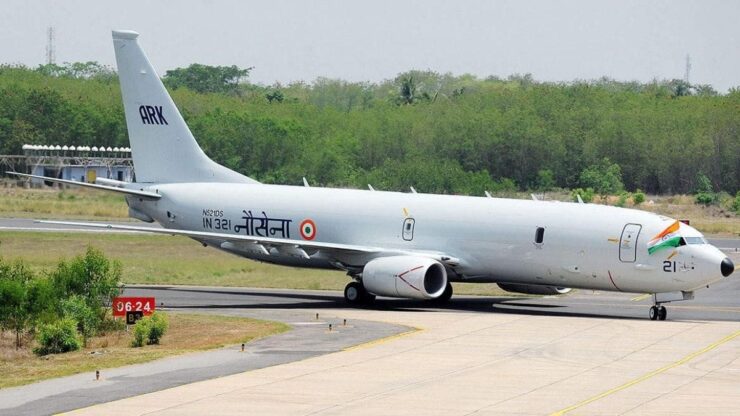In the morning hours of March 29, Chief of Naval Staff Admiral R Hari Kumar announced the commissioning of the second Naval squadron (INAS 316) equipped with P8I, long-range maritime reconnaissance multi-role aircraft, in an impressive ceremony at Naval base INS Hansa, Dabolin Airport, Goa. The squadron has been honoured with an insignia Condors, which is one of the largest flying birds with a massive wingspan and strong sharp beak for the kill. The Condors can fly gracefully for long hours and observe prey from the blue sky in deep oceans. Addressing the gathering at INS Hansa, the Naval Chief highlighted that India has a vast maritime boundary and economic zones, which have to be guarded through water and air at any cost at all times. India’s strategic location compels the Naval powers around the world to make us a preferred security partner in the Indian Ocean Zone, which reflects the country’s ability to play an effective strategic role for which we need to establish long operational reach as blue water Navy.
The birth of Condors is an important landmark in the relentless pursuance of the objective of the Indian Navy to dominate the high seas. Dabolin is already home for four Poseidon P8I since December 2021 and four more will join by year-end. The crew of these ‘wonder birds’ is fully integrated and trained for Deter, Detect and Destroy surface and subsurface missions. P8I is not new to the Indian Navy. There is another Naval squadron INAS 312 fondly called Albatross, a fully-operational unit with Eight P8I aircraft since 2016, based at INS Rajali, on the Eastern coast. These flying wonders actively participated in Operation Snow lion on strategic missions in the Himalayas over Karakoram Range. Albatross squadron was earlier had Russian Origin TU 142M NATO code name Bear, another strategic reconnaissance submarine hunter Turboprop aircraft in its inventory since 1976, which were used in Operation Cactus at the Maldives in 1987. The TU142M machines were declared obsolete in 2016 and Albatross were re-equipped with P8I aircraft nicknamed Neptune.
The Poseidon P8A is an American maritime patrol aircraft platform developed and produced by US Boeing Defence and security, space-based on Boeing 737-800 ERX Airframe. It was produced and developed for exclusive the US Navy. The aircraft platform was introduced in the US Navy in 2009 and is presently in service in four Navies around the world, including the United Kingdom, Australia and India. P8A is a long-range maritime surveillance aircraft for Anti-Submarine (ASW), Anti-surface warfare (ASUW) and shipping interdiction roles. The Platform is Armed with Anti-Ship Torpedoes and deadly Harpoon missiles and other weapons and can be further modified. It can drop and monitor son buoys and operate in conjunction with other surveillance and early warning equipment, and also link up with Triton UAVs.
P8A has been named Poseidon, an ancient powerful Greek God of Water, earthquakes and horses. The platform is based on a Boeing 737 and is meant for domination of maritime assets with state of art avionics – Raytheon APY 10 Multi-mission surface/ocean search radar, Electronic Support and warfare equipment, and AN/APS 154 Super Airborne sensors. It has a crew of two pilots and five support staff in mission mode. It is powered by two CFM56-7B27A Turbofan Jet engines. It can ferry weight of almost 10 tonnes. The cruise speed is 900 kmph. The combat range of the machine is 2222 km but can travel 8300km with additional fuel tanks. The service limit is almost 41000 feet. The Flying sentinel has 11 hardpoints for AGM Harpoon, Mark 54 Torpedoes, Anti-ship mines, Depth Charges, Glide Bombs and smart ammunition.
Indian Navy was for long searching for an alternative to ageing fleet of the most reliable Russian TU142M, which was acquired in 1976. Initially, HAL-manufactured Dornier 228 was considered as the replacement but it was not able to fill the gap as it was a tactical patrol aircraft with limited range and capability. Three Naval squadrons are already operating with Dornier 228. With the improvement in Indian-US relations in 2008, Boeing Defense and space was approached by the Indian government for the purchase of P8A through the US government. Boeing’s proposal was received in January 2008 for the sale of P8I, an export variant of P8A to the Indian Navy. An expert team of Test Pilots visited Boeing Defence USA and carried out a detailed study of the technical capabilities of the aircraft and also physical trials on P8I and found it custom-made for a long-range maritime surveillance platform.

It had two additional features as insisted by the Indian team – Magnetic Anomaly radar MAD and A telephonic APS 143 Ocean eye AFT radar. Finally, in January 2009, India’s defence minister signed a US$ 2.1 billion agreement with Boeing for the purchase of eight P8I Neptune to replace TU 142Ms. The first squadron of Albatross was stationed at INS Rajali Arakkonam, Ranipet, Tamil Nadu. Rajali base has the longest runway (4103 metres) in Asia and it received its first P8I in 2013, and a full complement balance of seven aircraft was acquired by 2016. Satisfied with the performance, the Indian Navy projected for an additional squadron of P8I for the Arabian Sea.
The present government approved the purchase of eight additional P8I for the second squadron and the contract was signed with Boeing by December 2021. Naval Headquarters selected INS Hansa as the new home for the second naval squadron with an aim to cover Western and Northern frontiers including the Arabian Sea. The additional four P8I aircraft have reached INS Hansa between December 2021 and March 2022. The dream of a second squadron materialised on March 29 this year. It was given the insignia of the Condor Sea bird and called INAS 316. Additional four aircraft will join by mid-2022, completing the process and declaring it fully operational.
Naval Aviation forms a formidable part of the Indian Navy and is growing and modernising rapidly. The directorate of Naval aviation was established in 1948 and Fleet regulating Unit was raised in 1953. The initial three naval units were equipped with Seahawks and Vampires. INS Vikrant, the first aircraft carrier ferried 24 aircraft of White Tigers (Seahawks), Cobras (Alize), and Harpoons (Chetak/ Seaking helicopters. Later, Sea Harriers joined Indian Navy fighter sqns. It was fondly called the Mother.
The Old Vikrant was decommissioned in 1997 and New Vikrant is emerging as the Lion of the Indian Ocean, while INS Vikramaditya holds the fort. White Tigers now possess MIG 29 K and Black Panthers hold MIG 29 KUB, the 4.5 Generation multi-role fighters have sharpened the claws of Indian Navy. Today, the Indian Navy is armed with 11 Fixed Wing sqns, nine Helicopter Units mainly equipped with HAL Dhurv, KA 28, and Sea King Heptrs and three UAV sqns have also been commissioned. Albatross were already hovering in the blue sky and Condors are airborne now, as the third eye in the sky guarding the blue horizon of the Nation.
-The writer is an Indian Army veteran and a defence analyst. He has keen interest in Geo-strategic affairs and writes regularly on internal and external affairs issues related to India and neighbours. The views expressed are personal and do not necessarily reflect the views of Raksha Anirveda.
-The writer is an Indian Army veteran and a defence analyst. He has keen interest in Geo-strategic affairs and writes regularly on internal and external affairs issues related to India and neighbours. The views expressed are personal and do not necessarily reflect the views of Raksha Anirveda






